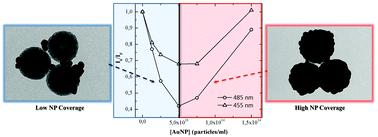Effect of metal nanoparticles on the photophysical behaviour of dye–silica conjugates
Abstract
Fluorescein has been covalently entrapped into 120 nm silica beads in order to measure the effect of plasmonic gold nanoparticles, having 25 nm diameter, on the radiative processes of the dye. Two distinct regimes of enhancement and quenching of fluorescein emission have been observed, depending on the concentration of the metal adsorbed on the silica surface and the overlap between the SPR and the fluorescein spectra. At particle concentrations below 5.0 × 1013 nanoparticles mL−1, the fluorescence of the dye is enhanced, and this effect is more pronounced when the excitation wavelength matches the maximum of the extinction spectrum of the gold nanoparticles. When the concentration of gold is further increased, quenching occurs and it has been attributed to the SPR shift following the aggregation of the gold colloids on the silica surface. The invariance of the fluorescence lifetimes during the whole process indicates that the mechanism of fluorophore–nanoparticle interaction is mainly based on changes in the absorption efficiency of the organic dye.

- This article is part of the themed collection: International Conference on Photochemistry 2013 (ICP2013) keynote lectures

 Please wait while we load your content...
Please wait while we load your content...